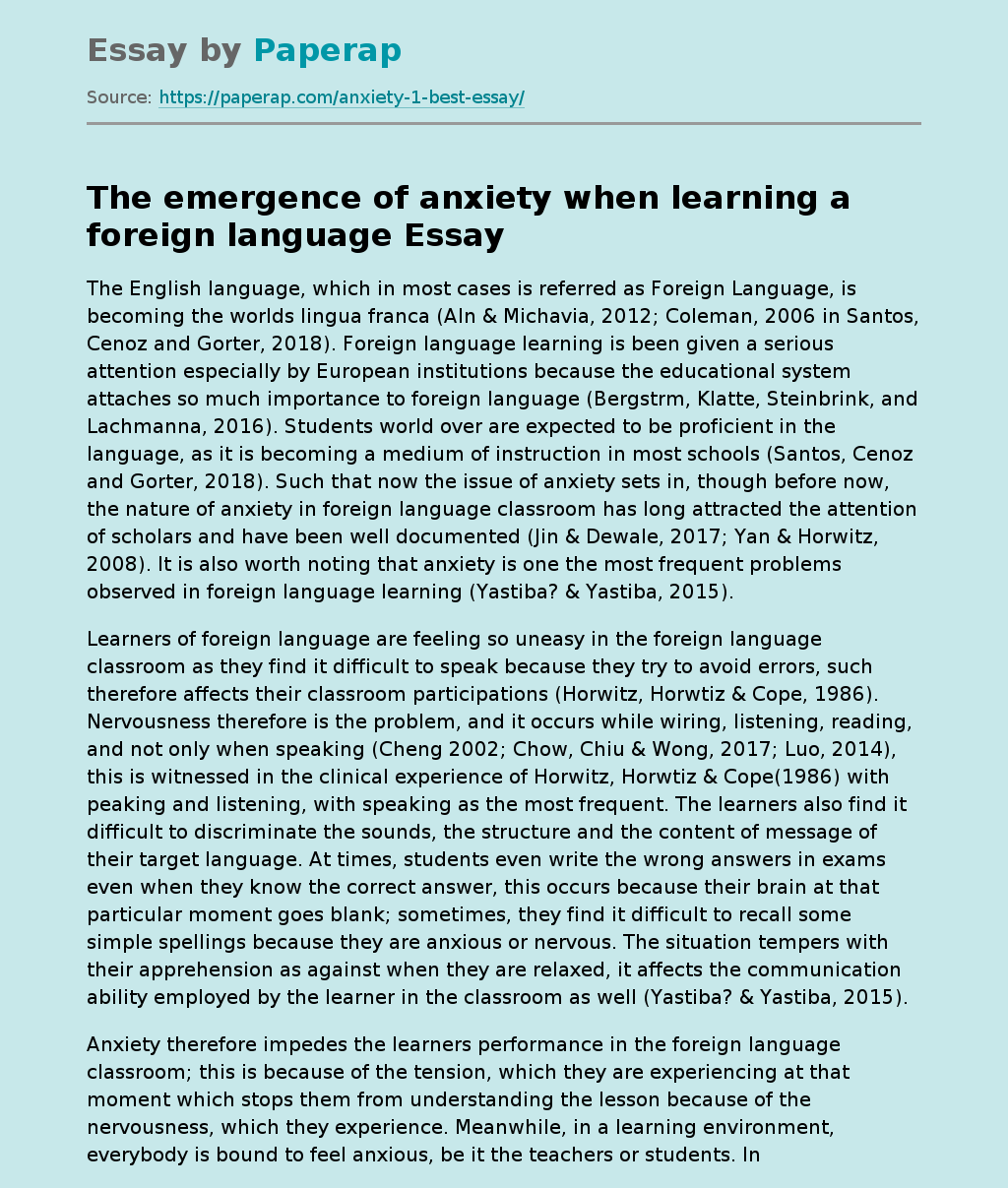The emergence of anxiety when learning a foreign language
The English language, which in most cases is referred as Foreign Language, is becoming the worlds lingua franca (Aln & Michavia, 2012; Coleman, 2006 in Santos, Cenoz and Gorter, 2018).
Foreign language learning is been given a serious attention especially by European institutions because the educational system attaches so much importance to foreign language (Bergstrm, Klatte, Steinbrink, and Lachmanna, 2016). Students world over are expected to be proficient in the language, as it is becoming a medium of instruction in most schools (Santos, Cenoz and Gorter, 2018). Such that now the issue of anxiety sets in, though before now, the nature of anxiety in foreign language classroom has long attracted the attention of scholars and have been well documented (Jin & Dewale, 2017; Yan & Horwitz, 2008). It is also worth noting that anxiety is one the most frequent problems observed in foreign language learning (Yastiba? & Yastiba, 2015).
Learners of foreign language are feeling so uneasy in the foreign language classroom as they find it difficult to speak because they try to avoid errors, such therefore affects their classroom participations (Horwitz, Horwtiz & Cope, 1986).
Nervousness therefore is the problem, and it occurs while wiring, listening, reading, and not only when speaking (Cheng 2002; Chow, Chiu & Wong, 2017; Luo, 2014), this is witnessed in the clinical experience of Horwitz, Horwtiz & Cope(1986) with peaking and listening, with speaking as the most frequent. The learners also find it difficult to discriminate the sounds, the structure and the content of message of their target language. At times, students even write the wrong answers in exams even when they know the correct answer, this occurs because their brain at that particular moment goes blank; sometimes, they find it difficult to recall some simple spellings because they are anxious or nervous.
The situation tempers with their apprehension as against when they are relaxed, it affects the communication ability employed by the learner in the classroom as well (Yastiba? & Yastiba, 2015).
Anxiety therefore impedes the learners performance in the foreign language classroom; this is because of the tension, which they are experiencing at that moment which stops them from understanding the lesson because of the nervousness, which they experience. Meanwhile, in a learning environment, everybody is bound to feel anxious, be it the teachers or students. In addition, Krashen beliefs that anxiety affects language input, so it plays a major part in affective filter which does not allow learners to take in message from the target language being learned, leading to poor performance in class during language lessons (Horwitz, Horwtiz & Cope, 1986; Horwtiz, 2013).
D?rnyei and Ryan (2015) in Jin & Dewale (2017) state that foreign language learners outcome differ. This is because of individual differences, this most at times manifests in their learning motivations, the usable resources, language aptitude, their attitudes towards their target language community. Anxiety therefore serves as main barriers between the foreign language learner and the target language (?a?atay, 2015; Yastiba? & Yastiba?, 2015).
This study therefore, is different from other studies which were done on foreign language anxiety. Most of the previous studies payed more attention to foreign language anxiety negative emotion such as causes and consequences, with some dwelling on the position orientation, considering students and teachers emotion support for foreign language classroom anxiety (Jin & Dewale, 2017). The present aims at determining the level of foreign language classroom anxiety experienced by the students of the preparatory school at Eastern Mediterranean University (EMU).
Anxiety therefore serves as main barriers between the foreign language learner and the target language.Foreign language is a kind of situation though may be close to trait and state anxiety, but it is distinct in form. Even though it occurs in communication, reading as well as pronunciation, they are all classified as foreign language anxiety. Anxiety equally occurs when learners are in distress concerning their inability to be themselves and their limitation in the new language (Horwtiz, 2007; Jin & Dewaele, 2018). As anxiety has been under a long time study, the findings indicate that the foreign language anxiety interferes with the learners foreign language learning and performance in various domains and have negative effects on the learners cognitive, academic as well as social. Invariably, the learners chance to develop his/her proficiency is weakened favouring anxiety and creating a vicious circle (Jin & Dewaele, 2018). Students who are anxiety or nervous in away try to avoid communicating with others, they tend miss classes, and writing situation, they prefer writing at home or outside the class, as they fear that their foreign language output may be judged negatively and such can further undermined even the teachers effort (Dewaele & MacIntyre, 2014; Horwtiz, Hortiz & Cope, 1986; Tsui, 1991).
Investigations show that the occurrence of anxiety in foreign language learning varies based on individual differences in anxiety levels, which are connected to their demographic background both social and cultural, their proficiency levels and their foreign language learning experience (Jin & Dewaele, 2018). Peoples levels of responding to foreign language anxiety differ as investigated within the lives of broad personality traits and lower-order personality aspects. The broad traits indicate that the only personality traits that presented a significant negative path to foreign language anxiety is extraversion.
There is a negative relationship between extraversion and foreign language anxiety as individuals with high psychoticism and emotional stability suffer less anxiety in the foreign language classroom during speaking. Personality is equally associated with emotional intelligence (Trait E). Foreign language learners classroom anxiety could be high possibly from cognitive and evaluation of the classroom environment as it has both internal and social dimension (Dewaele, 2013, 2017a; Dewaele, Petrides & Fuenham, 2008; MacIntyre & Charos, 1996; Jin & Dewaele, 2018; MacInyre, 2017).
The emergence of anxiety when learning a foreign language. (2019, Nov 24). Retrieved from https://paperap.com/anxiety-1-best-essay/

